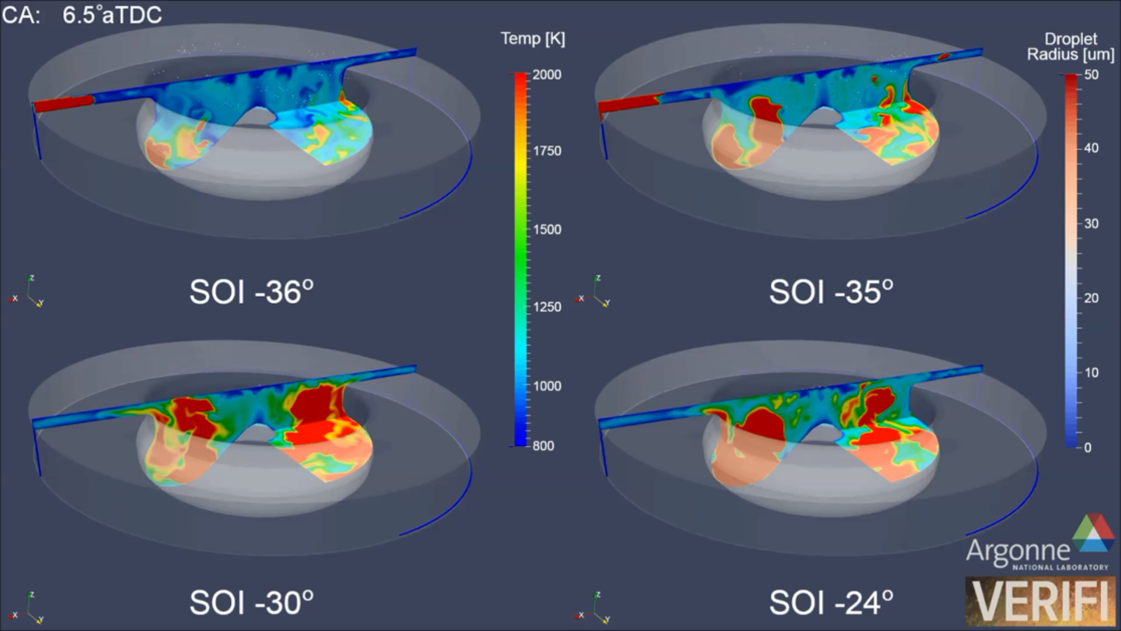An Argonne National Laboratory team is combining software innovations with supercomputing advances to jump-start internal-combustion engine designs in the name of conservation.
“Even with the push toward electrification in the automotive sector, it’s estimated that there are over 200 million internal combustion engines sold a year,” says Sibendu Som, an Argonne Energy Systems Division mechanical engineer who is technical lead investigator for the lab’s Virtual Engine Research Institute and Fuels Initiative (VERIFI).
“Improving engine efficiencies by even a few percentage points can take a big chunk out of our carbon footprint,” Som says. “We are working on a proof-of-concept to demonstrate how simulating several thousand engine configurations simultaneously can really help engineers zero in on the optimum engine designs and operating strategies to maximize efficiency while minimizing harmful emissions.”
To do this, Som and colleagues are using 60 million processor hours on Mira, an IBM Blue Gene/Q at the Argonne Leadership Computing Facility (ALCF). The computing time is through the Department of Energy’s Advanced Scientific Computing Research Leadership Computing Challenge program. Som’s co-investigators include fellow mechanical engineer Janardhan Kodavasal, ALCF principal project specialist Marta García and ALCF senior software developer Kevin Harms.
Industry researchers may run perhaps tens of simulations at a time to reduce the costly need to build physical prototypes when evaluating new engine designs, Som says. But “we are talking about running on the order of 10,000 engine simulations concurrently (because) piston shape, injector design, valve and fuel injection strategies, and fuel composition need to be evaluated simultaneously.” Until recently, running thousands of simultaneous simulations “was not possible because computing resources were not there, nor the technology. In this project we have access to both.”
‘We’re trying to make sure that every processor is solving the same amount of computational work.’
By “technology,” Som means special coding. The VERIFI team’s main engine simulation code is CONVERGE, fluid dynamics software made by Convergent Science. The program constantly updates conditions in the engine model to track changeable elements like moving parts.
The group also uses a high-level and resilient parallel programming language called Swift, developed by Argonne’s Mathematics and Computer Science Division, to orchestrate the multitude of independent simulations running concurrently on Mira. Swift, Som adds, can execute thousands of simulations at once without overburdening Mira’s infrastructure.
A paper Kodavasal, Harms, García, Som and others published this year in the Journal of Energy Resources Technology describes the development of another VERIFI adaptation: a so-called stiffness-based algorithm that spreads out the parallel-processing loads on high-performance computers.
“We’re trying to make sure that every processor is solving the same amount of computational work,” Kodavasal explains. With their innovations, the authors say, a simulation of multiple versions of an advanced combustion chamber at one stage of an engine cycle ran more than three times faster while using 4,096 Mira cores.
With all those tools, the Argonne group can load up crucial details as it models, among other things, turbulence, combustion chemistry and how much heat is lost as waste energy within the engine head, cylinder walls and pistons. All those calculations – done at every simulation time step – can translate into a single color-coded image of fuel spraying in as a piston nears its top-center position, at the end of its compression stroke with ignition about to occur. Som says all of a four-stroke engine’s cycles can be similarly detailed. A single engine cycle happens in a blink, but “the computer can take several hours to simulate this.”
The simulated combustion chamber is modeled after a 1.9-liter General Motors diesel engine sold in Europe in makes like Opel. As in today’s diesel automobiles, this experimental design would run without a spark plug and, instead of diesel, could use 87-octane gasoline.
Typical gasoline engines need a spark and cannot operate lean – that is, with abundant air in their mixing ratios. Diesel engines run lean and without spark plugs because diesel fuel can ignite purely through piston compression. In fact, lean operation is a major reason diesel engines are more efficient than their gasoline counterparts.
On the down side, diesel systems’ inherently lean mixing ratios produce exhausts with plentiful oxides of nitrogen, and the fuel’s high viscosity creates soot. So U.S. emission standards say diesels must have catalytic systems and particulate filters “that are more expensive and complicated than the simple three-way catalysts used on gasoline systems,” Som says. A gasoline engine that could be modified to operate lean like a diesel but still run on gas and thus not require expensive catalytic systems would offer the best of both worlds, Som says. Reducing fuel consumption would emit less climate-changing carbon dioxide and save drivers money if new technology also could address emissions.
In fact, the group’s paper describes a gasoline compression ignition (GCI) engine that would do exactly that. “With our simulations we were able to manipulate the fuel-injection event to make it a lot easier for gasoline to burn in the lean environment of a diesel engine without using a spark,” Som says. Further, GCI is what’s known as a flameless combustion mode: Unlike typical gasoline or diesel combustion, it produces orders of magnitude less oxides of nitrogen, even while operating lean. That lessens dependence on especially costly catalytic systems to scrub exhaust.
To reach that goal, the VERIFI team is part of a recently announced $13 million project involving Argonne, Achates Power Inc., Delphi Automotive and the DOE’s Advanced Research Projects Agency-Energy to create such a combustion system – a so-called super engine.
Says Som, “With advances in digital sensors, control systems, and computer simulations, we are now closer than ever before.”
